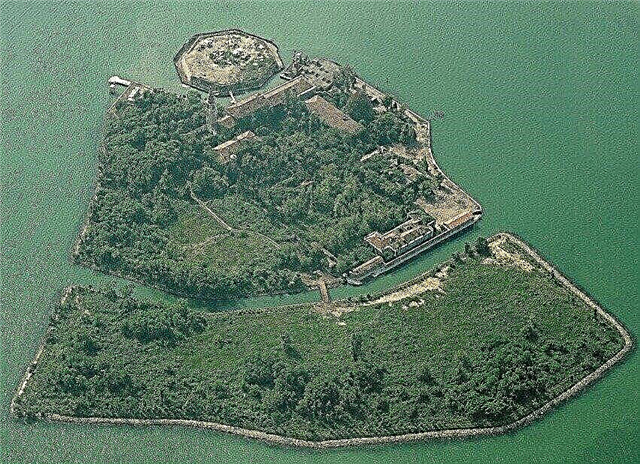Elizabeth or Erzhebet Bathory of Eched or Alzhbeta Batorova-Nadashdi, also called Chakhtitskaya Pani or Bloody Countess (1560-1614) - Hungarian countess from the Bathory family, and the richest aristocrat of Hungary of her time.
She became famous for the serial murders of young girls. Listed in the Guinness Book of Records as the woman who killed the most people - 650.

There are many interesting facts in Bathory's biography, which we will talk about in this article.
So, before you is a short biography of Elizabeth Bathory.
Biography Bathory
Elizabeth Bathory was born on August 7, 1560 in the Hungarian city of Nyirbator. She grew up and was brought up in a wealthy family.
Her father, Gyorgy, was the brother of the Transylvanian governor Andras Bathory, and her mother Anna was the daughter of another governor, Istvan 4. In addition to Elizabeth, her parents had 2 more girls and one boy.
Elizabeth Bathory spent her childhood in Eched Castle. During this biography time she studied German, Latin and Greek. The girl periodically suffered from sudden seizures, which could be due to epilepsy.
Incest negatively affected the mental state of the family. According to some sources, everyone in the Bathory family suffered from epilepsy, schizophrenia and alcohol addiction.
At a young age, Bathory often fell into an unreasonable rage. It is worth noting that she professed Calvinism (one of the religious movements of Protestantism). Some biographers suggest that it was the countess's faith that could have caused the massacres.
Personal life
When Bathory was barely 10 years old, her parents betrothed their daughter to Ferenc Nadashdi, the son of Baron Tamash Nadashdi. Five years later, the wedding of the bride and groom took place, which was attended by thousands of guests.
Nadashdi gave his wife the Chakhtitsa Castle and 12 villages around it. After her marriage, Bathory was alone for a long time, as her husband studied in Vienna.
In 1578 Ferenc was entrusted to lead the Hungarian troops in the battles against the Ottoman Empire. While her husband was fighting on the battlefield, the girl was engaged in the household and managed the affairs. In this marriage, six children were born (according to other sources, seven).
All the children of the Bloody Countess were brought up by governesses, while she herself did not pay them worthy attention. An interesting fact is that according to rumors, 13-year-old Bathory, even before her marriage to Nadashdi, became pregnant by a servant named Sharvar Laszlo Bendé.
When Ferenc became aware of this, he ordered to castrate Benda, and ordered the baby girl, Anastasia, to be separated from Elizabeth in order to save the family from shame. However, the lack of reliable documents confirming the existence of the girl may indicate that she could have been killed in infancy.

When Bathory's husband participated in the Thirty Years War, the girl took care of his estates, which were attacked by the Turks. There are many known cases when she defended dishonored women, as well as those whose daughters were raped and pregnant.
In 1604 Ferenc Nadashdi died, who at that time was about 48 years old. On the eve of his death, he entrusted Count Gyordu Thurzo to take care of his children and wife. Curiously, it is Thurzo who will later investigate Bathory's crimes.
Prosecution and investigation
In the early 1600s, rumors of the Blood Countess's atrocities began to spread throughout the kingdom. One of the Lutheran clerics suspected her of performing occult rituals, and reported to the local authorities.
However, officials did not pay enough attention to these reports. Meanwhile, the number of complaints against Bathory increased so much that the countess's crimes were already discussed throughout the state. In 1609, the topic of the murder of women noblewomen began to be actively discussed.
Only after that, a serious investigation of the case began. In the next 2 years, the testimony of over 300 witnesses was collected, including the servants of the Sarvar castle.
The testimonies of the people interviewed were shocking. People claimed that Countess Bathory's first victims were young girls of peasant origin. The woman invited the unfortunate teenagers to her castle under the pretext of becoming her servant.
Later, Bathory began to mock poor children, who were severely beaten, biting off the flesh from the face, limbs and other parts of the body. She also doomed her victims to starvation or freeze them.
The accomplices of Elizabeth Bathory took part in the atrocities described, who delivered girls to her by deception or violence. It is worth noting that stories about Bathory bathing in the blood of virgins in order to preserve her youth are questionable. They arose after the death of the woman.
Bathory's arrest and trial
In December 1610 Gyordu Thurzo arrested Elizabeth Bathory and four of her accomplices. Gyordu's subordinates found one girl dead and one dying, while the other prisoners were locked in a room.
There is an opinion that the countess was arrested at the moment when she was allegedly found in the blood, but this version has no reliable evidence.
The trial over her and her accomplices began on January 2, 1611. An interesting fact is that Bathory refused to express his opinion about the atrocities committed and was not even allowed to be present at the trial.

The exact number of victims of the Bloody Countess is still unknown. Some witnesses spoke of dozens of tortured and murdered girls, while others named more significant figures.
For example, a woman named Zhuzhanna told about Bathory's book, which allegedly contained a list of over 650 victims. But since the number 650 could not be proven, 80 victims were officially recognized.
Today, 32 letters written by the Countess have survived, which are stored in the Hungarian archives. Sources call a different number of people killed - from 20 to 2000 people.
Elizabeth Bathory's three female accomplices were sentenced to death. Two of them tore off their fingers with hot tongs and then burned them at the stake. The third accomplice was beheaded, and the body was set on fire.
Death
After the end of the trial, Bathory was imprisoned in a solitary confinement at Cheyte Castle. At the same time, the doors and windows were blocked with bricks, as a result of which only a small ventilation hole remained, through which food was served to the prisoner.
In this place, Countess Bathory stayed until the end of her days. According to other sources, she spent the rest of her life under house arrest, being able to move around the castle.
On the day of her death on August 21, 1614, Elizabeth Bathory complained to the guard that her hands were cold, but he recommended that the prisoner lie down. The woman went to bed, and in the morning she was found dead. Biographers still do not know the true burial place of Bathory.
Bathory Photos















